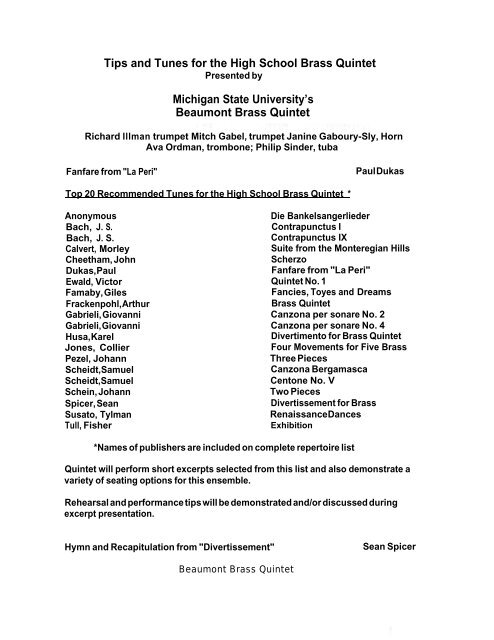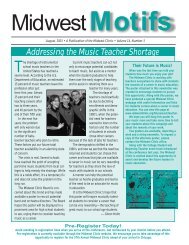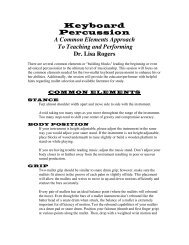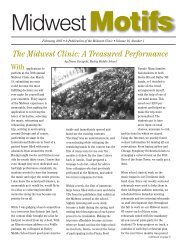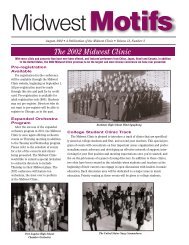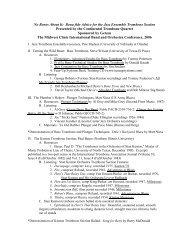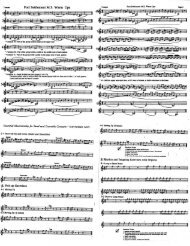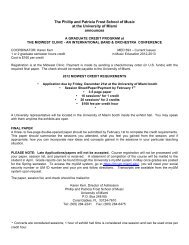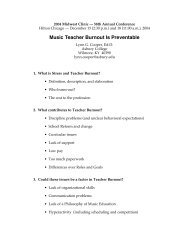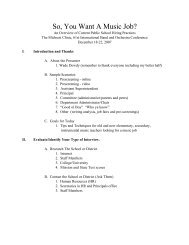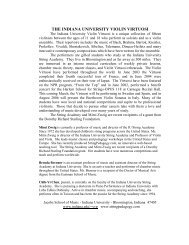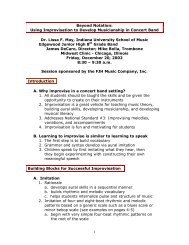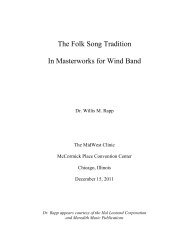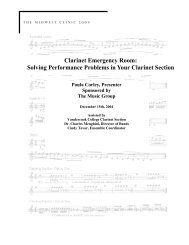Tips and Tunes for the High School Brass Quintet - The Midwest Clinic
Tips and Tunes for the High School Brass Quintet - The Midwest Clinic
Tips and Tunes for the High School Brass Quintet - The Midwest Clinic
Create successful ePaper yourself
Turn your PDF publications into a flip-book with our unique Google optimized e-Paper software.
<strong>Tips</strong> <strong>and</strong> <strong>Tunes</strong> <strong>for</strong> <strong>the</strong> <strong>High</strong> <strong>School</strong> <strong>Brass</strong> <strong>Quintet</strong><br />
Presented by<br />
Michigan State University’s<br />
Beaumont <strong>Brass</strong> <strong>Quintet</strong><br />
Richard Illman trumpet Mitch Gabel, trumpet Janine Gaboury-Sly, Horn<br />
Ava Ordman, trombone; Philip Sinder, tuba<br />
Fanfare from "La Peri" Paul Dukas<br />
Top 20 Recommended <strong>Tunes</strong> <strong>for</strong> <strong>the</strong> <strong>High</strong> <strong>School</strong> <strong>Brass</strong> <strong>Quintet</strong> *<br />
Anonymous Die Bankelsangerlieder<br />
Bach, J. S. Contrapunctus I<br />
Bach, J. S. Contrapunctus IX<br />
Calvert, Morley Suite from <strong>the</strong> Monteregian Hills<br />
Cheetham, John Scherzo<br />
Dukas, Paul Fanfare from "La Peri"<br />
Ewald, Victor <strong>Quintet</strong> No. 1<br />
Famaby, Giles Fancies, Toyes <strong>and</strong> Dreams<br />
Frackenpohl, Arthur <strong>Brass</strong> <strong>Quintet</strong><br />
Gabrieli, Giovanni Canzona per sonare No. 2<br />
Gabrieli, Giovanni Canzona per sonare No. 4<br />
Husa, Karel Divertimento <strong>for</strong> <strong>Brass</strong> <strong>Quintet</strong><br />
Jones, Collier Four Movements <strong>for</strong> Five <strong>Brass</strong><br />
Pezel, Johann Three Pieces<br />
Scheidt, Samuel Canzona Bergamasca<br />
Scheidt, Samuel Centone No. V<br />
Schein, Johann Two Pieces<br />
Spicer, Sean Divertissement <strong>for</strong> <strong>Brass</strong><br />
Susato, Tylman Renaissance Dances<br />
Tull, Fisher Exhibition<br />
*Names of publishers are included on complete repertoire list<br />
<strong>Quintet</strong> will per<strong>for</strong>m short excerpts selected from this list <strong>and</strong> also demonstrate a<br />
variety of seating options <strong>for</strong> this ensemble.<br />
Rehearsal <strong>and</strong> per<strong>for</strong>mance tips will be demonstrated <strong>and</strong>/or discussed during<br />
excerpt presentation.<br />
Hymn <strong>and</strong> Recapitulation from "Divertissement" Sean Spicer<br />
Beaumont <strong>Brass</strong> <strong>Quintet</strong>
<strong>Clinic</strong> Synopsis<br />
A survey of <strong>the</strong> most appropriate works composed or arranged <strong>for</strong> brass quintet<br />
at <strong>the</strong> high school level, along with an explanation of <strong>the</strong> best seating<br />
configurations <strong>for</strong> <strong>the</strong> ensemble.<br />
<strong>Clinic</strong> Outline<br />
This session by <strong>the</strong> Beaumont <strong>Brass</strong> <strong>Quintet</strong> will be geared toward building a<br />
successful high school brass quintet. <strong>The</strong> quintet will per<strong>for</strong>m excerpts from <strong>the</strong><br />
most appropriate original <strong>and</strong> transcribed works <strong>for</strong> brass quintet at <strong>the</strong> high<br />
school level <strong>and</strong> will provide a h<strong>and</strong>out listing <strong>and</strong> grading pieces <strong>for</strong> this<br />
ensemble. O<strong>the</strong>r topics to be covered include viable seating options <strong>for</strong> <strong>the</strong> brass<br />
quintet <strong>and</strong> selected rehearsal techniques that can enhance <strong>the</strong> success of <strong>the</strong><br />
high school ensemble.<br />
Biographical Sketch<br />
<strong>The</strong> Beaumont <strong>Brass</strong> is <strong>the</strong> faculty brass quintet from <strong>the</strong> <strong>School</strong> of Music at<br />
Michigan State University, East Lansing, Ml. Named <strong>for</strong> <strong>the</strong> l<strong>and</strong>mark bell tower<br />
located in <strong>the</strong> scenic older part of <strong>the</strong> MSU campus, <strong>the</strong> group was <strong>for</strong>med in<br />
1989. <strong>The</strong> Beaumont <strong>Brass</strong> have per<strong>for</strong>med throughout Michigan <strong>and</strong> <strong>the</strong><br />
<strong>Midwest</strong>, presenting concerts <strong>and</strong> clinics in a variety of settings, from public<br />
schools to campus concert halls, from guest appearances with <strong>the</strong> Empire <strong>Brass</strong><br />
<strong>and</strong> Canadian <strong>Brass</strong> to concerts in Sou<strong>the</strong>ast Michigan churches. Members of<br />
<strong>the</strong> Beaumont <strong>Brass</strong> include both faculty <strong>and</strong> graduate students with several<br />
<strong>for</strong>mer student members having subsequently won positions in <strong>the</strong> Saint Louis<br />
Symphony, Chicago Symphony, Gr<strong>and</strong> Rapids Symphony, Lansing Symphony,<br />
United States Marine B<strong>and</strong>, Ft. Wayne Philharmonic, <strong>and</strong> at Eastern Michigan<br />
University. In 2000 <strong>the</strong> Beaumont <strong>Brass</strong> released <strong>the</strong>ir first recording, "Christmas<br />
at Beaumont Tower." (Mark Records #3609 MCD)<br />
<strong>The</strong> Beaumont <strong>Brass</strong> wish to thank <strong>the</strong> <strong>School</strong> of Music at Michigan State<br />
University <strong>for</strong> sponsoring this clinic presentation.<br />
To obtain a copy of our compact disc recording, "Christmas at Beaumont Tower"<br />
(Mark Records #3609 MCD), contact Mark Records, 10815 Bodine Road,<br />
Clarence, NY 14031-0406, or visit www.markcustom.com
Possible <strong>Brass</strong> <strong>Quintet</strong> Setups<br />
1. This setup makes <strong>the</strong> trumpets prominent but antiphonal. It also has <strong>the</strong> horn pointing towards <strong>the</strong> audience, which<br />
tends to make it stronger in <strong>the</strong> mix.<br />
Tpt 1 Tpt 2<br />
Tbn Horn<br />
Tuba<br />
2. Setup A. brings out <strong>the</strong> trombone part better than #1, B. brings out <strong>the</strong> horn, <strong>and</strong> both soften Trumpet 2.<br />
A. Tpt 1 Tbn B. Tpt 1 Horn<br />
Tpt 2 Horn Tpt 2 Tbn<br />
Tuba Tuba<br />
3. In this setup, all players, except <strong>the</strong> tuba, would angle more towards <strong>the</strong> audience, which brings out all parts, except <strong>the</strong><br />
tuba.<br />
Tpt 1 Tpt 2<br />
Tbn Horn<br />
Tuba<br />
4. This setup, often used by <strong>the</strong> Empire <strong>Brass</strong> <strong>Quintet</strong>, has all bells facing <strong>the</strong> audience.<br />
Tuba Tbn Tpt 1 Tpt 2 Horn<br />
5. This setup brings out <strong>the</strong> horn <strong>and</strong> trombone while making <strong>the</strong> trumpets softer.<br />
Tbn Horn<br />
Tpt 1 Tpt 2<br />
Tuba<br />
6. This setup brings out <strong>the</strong> Tuba while making <strong>the</strong> Horn <strong>and</strong> Tpt 2 softer.<br />
Tuba Tpt 1<br />
Tbn Tpt 2<br />
Horn<br />
7. This setup brings out <strong>the</strong> trombone while making <strong>the</strong> trumpets <strong>and</strong> horn softer.<br />
Horn Tbn<br />
Tpt 1 Tpt 2<br />
Tuba
Rich Illman, Trumpet<br />
General <strong>Tips</strong> <strong>for</strong> <strong>Brass</strong> <strong>Quintet</strong>s<br />
Presented by<br />
<strong>The</strong> Beaumont <strong>Brass</strong> <strong>Quintet</strong><br />
Michigan State University<br />
1 Practice coming in on one note from <strong>the</strong> first trumpet player’s downbeat.<br />
2 Practice playing one measure at <strong>the</strong> same tempo from <strong>the</strong> first trumpet player’s downbeat.<br />
3 Have <strong>the</strong> first trumpet player practice breathing in rhythm when <strong>the</strong>y start a piece.<br />
4 Practice rhythmic sections with a loud metronome.<br />
5 Practice complex rhythmic passages with a drum machine playing downbeats <strong>and</strong> subdivisions.<br />
6 Practice tuning chords by starting with <strong>the</strong> roots first, <strong>the</strong>n adding <strong>the</strong> fifths, <strong>the</strong>n thirds, <strong>the</strong>n any o<strong>the</strong>r notes that are<br />
left. Note that <strong>the</strong> third of a major chord should be flatter than normal (fourteen cents) <strong>and</strong> <strong>the</strong> third of a minor chord<br />
should be sharper than normal (16 cents)<br />
7 Practice cutting off chords toge<strong>the</strong>r by deciding on <strong>the</strong> exact time with a metronome. <strong>The</strong>n practice <strong>the</strong> cutoff with <strong>the</strong><br />
metronome until it is toge<strong>the</strong>r. Once that is achieved, turn off <strong>the</strong> metronome <strong>and</strong> see if it can still be done toge<strong>the</strong>r.<br />
Janine Gaboury-Sly, Horn<br />
1 Particularly in louder passages have <strong>the</strong> horn player play with <strong>the</strong> bell off <strong>the</strong> leg <strong>and</strong> raised a bit higher <strong>for</strong> better<br />
projection.<br />
2 Be sure that <strong>the</strong> h<strong>and</strong> is open in <strong>the</strong> bell to blend well with <strong>the</strong> o<strong>the</strong>r brass instruments.<br />
Mitch Gabel, Trumpet<br />
1 Know when you have <strong>the</strong> melody line or an accompanimental line. If you have <strong>the</strong> melody, more times than not you<br />
will want to lead <strong>the</strong> ensemble with that lead line. When you have an accompanimental line you will want to adjust<br />
your dynamics accordingly [softer] so that <strong>the</strong> melody can be heard. <strong>The</strong> sooner you can grasp this concept <strong>the</strong> better<br />
your chamber ensemble will be but more importantly, <strong>the</strong> better a musician YOU will be.<br />
2 Try your best to have your parts completely learned [key/time signatures, rhythms, notes, mute changes] as soon as<br />
possible so that you can concentrate on ensemble issues. Not having your part down will impede upon <strong>the</strong> ensembles<br />
progress. This is true of any musical situation.<br />
Ava Ordman, Trombone<br />
1 Often <strong>the</strong> low brass get covered, especially when <strong>the</strong> set-up has <strong>the</strong> trumpets on <strong>the</strong> outside. Be aware of this <strong>and</strong> adjust<br />
dynamics accordingly.<br />
2 Eye contact <strong>and</strong> body language can be very important in per<strong>for</strong>ming chamber music. Getting to know your colleagues’<br />
tendencies in <strong>the</strong>se areas will enhance <strong>the</strong> ensemble’s ability to play more as a whole. Consistent ensemble time,<br />
rhythm, <strong>and</strong> dynamics as well as breathing <strong>and</strong> phrasing can become second nature to <strong>the</strong> sensitive chamber music<br />
player.<br />
Philip Sinder, Tuba<br />
1 For <strong>the</strong> brass quintet in general, develop your rehearsal success by working on selected difficult passages with fewer<br />
than five players. Practicing a section of a piece with only two or three voices can quickly straighten out metric<br />
precision, balance, <strong>and</strong> intonation. Plus, o<strong>the</strong>rs in <strong>the</strong> quintet not playing at that moment can offer advice to <strong>the</strong> o<strong>the</strong>rs<br />
<strong>for</strong> improvement.<br />
2 For <strong>the</strong> tubist, be sure to consider <strong>the</strong> following:<br />
a. Always listen <strong>for</strong> good balance <strong>and</strong> style within <strong>the</strong> quintet setting. Since most high school tubists will employ a<br />
tuba in <strong>the</strong> brass quintet, be sure to play with a clean, accurate style, <strong>and</strong> avoid overpowering <strong>the</strong> o<strong>the</strong>rs.<br />
b. <strong>The</strong> tubist sets <strong>the</strong> stage metrically in a brass quintet. Be certain to stay on top of <strong>the</strong> beat <strong>and</strong> to consider yourself a<br />
leader rhythmically.<br />
c. You must play in tune with yourself, <strong>and</strong> set a strong foundation <strong>for</strong> <strong>the</strong> o<strong>the</strong>r brass to rely on <strong>for</strong> placing <strong>the</strong>ir voice<br />
in <strong>the</strong> chord_
A Graded List of Repertoire<br />
<strong>for</strong> Young <strong>Brass</strong> <strong>Quintet</strong>s<br />
Rating System - 5: College/Advanced <strong>High</strong> <strong>School</strong>, 4: Advanced <strong>High</strong> <strong>School</strong>, 3: Moderate <strong>High</strong><br />
<strong>School</strong>, 2: Easy <strong>High</strong> <strong>School</strong>, 1: Easy <strong>High</strong> <strong>School</strong>, Middle <strong>School</strong><br />
*Pieces followed by an asterisk are covered in more detail in <strong>the</strong> Beaumont <strong>Brass</strong> Favorites<br />
Composer Title Publisher Level<br />
Adson 2 Ayres <strong>for</strong> Cornetts <strong>and</strong> Robert King 2<br />
Sackbutts<br />
Anonymous Sonata from Robert King 2/3*<br />
Die Bankelsangelieder<br />
Arnold, Malcolm <strong>Quintet</strong> Paterson 4/5*<br />
Baber <strong>The</strong>me <strong>and</strong> Fantasia Shawnee 3/4<br />
Bach, J.S. Contrapunctus I Robert King 3/4*<br />
Bach Contrapunctus IX Chamber Music Lib. 4<br />
Bach Fugue in G Major, “<strong>The</strong> Little” Gordon Thompson 3<br />
Bach Sheep May Safely Graze Gordon Thompson 2<br />
Bach Menuet in G Medici Music Press 1<br />
Bach Musette Medici 1<br />
Bach Jesu, Joy of Man’s Desiring Queen City <strong>Brass</strong> Pub. 3<br />
Bach Chorale <strong>and</strong> Fughetta Kendor Music 1<br />
Bach Fugue in g minor Canadian <strong>Brass</strong> Pub. 3/4<br />
Baron Impressions of a Parade G. Schirmer 3<br />
Beach Music <strong>for</strong> <strong>Brass</strong> <strong>Quintet</strong> <strong>The</strong>odore Presser 3<br />
Brade 2 Pieces Robert King 2<br />
Brahms Es ist ein Ros’ entsprungen Robert King 2/3<br />
Calvert 3 Dance Impressions Ber<strong>and</strong>ol Music 3/4<br />
Calvert Suite from Monteregian Hills Ber<strong>and</strong>ol Music 3/4*<br />
Charpentier Prelude Te Deum PP Music 2/3
Cheetham Scherzo Western International 3/4*<br />
Conversi Three Canzonas Ludwig Music Pub. 3<br />
Dukas Fanfare from 'La Peri' <strong>The</strong>odore Presser Co. 4/5*<br />
Ewald <strong>Quintet</strong> Ensemble Publications 4/5*<br />
Ewazen A Western Fanfare Sou<strong>the</strong>rn Music Co. 4<br />
Farnaby Fancies, Toyes, <strong>and</strong> Dreams Chester Music, Ltd. 3*<br />
Ferrabosco Two Madrigals Ludwig Music Pub. 3<br />
Frackenpohl <strong>Brass</strong> <strong>Quintet</strong> <strong>The</strong>odore Presser Co. 4*<br />
Gabrieli Canzona per sonare No. 2 Robert King Music Co. 3*<br />
Gabrieli Canzona per sonare No. 4 Robert King Music Co. 3*<br />
Glasel, ed. 16 th Century Carmina Chamber Music Library 3<br />
Grieg 3 Norwegian <strong>Tunes</strong> J & W Chester 2<br />
Haas Two 16 th Century Flemish Songs Shawnee Press 3<br />
Haines Sonata Robert King 5<br />
Haines Toccata Robert King 5<br />
H<strong>and</strong>el 2 Arias Sto-Art Publications 3/4<br />
Harris 4 Moods Mentor Music 3<br />
Holborne 2 Pieces Robert King 2<br />
Holborne 5 Pieces Robert King 2<br />
Holborne 3 Pieces Robert King 2<br />
Holmes <strong>Brass</strong> <strong>Quintet</strong> Shawnee Press 3<br />
Holst 2 nd Military Suite in F Touch of <strong>Brass</strong> 3/4<br />
Hopkins <strong>Brass</strong> <strong>Quintet</strong> I Crown Music Press 3<br />
Horovitz Music Hall Suite Novello & Co. 4<br />
Howarth 4 Swiss <strong>Tunes</strong> J. & W. Chester 3/4<br />
Husa Divertimento <strong>for</strong> <strong>Brass</strong> <strong>Quintet</strong> Associated Music Pub. 4/5*
Ives 4 Songs Sou<strong>the</strong>rn Music 2<br />
Iveson Frere Jacques J. & W. Chester 3/4<br />
Jenkins Newark Seige Queen City <strong>Brass</strong> Pub. 3<br />
Jones 4 Movements <strong>for</strong> 5 <strong>Brass</strong> Mentor Music 3/4*<br />
Josquin Motet <strong>and</strong> Royal Fanfare Robert King 1<br />
Kempton Dimensions in <strong>Brass</strong> Kendor music 1<br />
Kessel Sonata mit blasende Instrumenten Robert King 2<br />
Lebow Popular Suite Sou<strong>the</strong>rn Music 2<br />
Mauer 3 Pieces Mentor Music 2/3<br />
Mauer Scherzo <strong>and</strong> Lied Mentor Music 2/3<br />
Mendelssohn He That Shall Endure Medici Music Press 1<br />
Mendelssohn Tarantella J. & W. Chester 3/4<br />
Mouret Rondeau Robert King 3/4<br />
Moussorgsky Hopak Crown Music Press 2<br />
Nagel This Old Man March Mentor Music 3<br />
Peurl Canzoni No. 1 <strong>The</strong>odore Presser 2<br />
Peurl Canzoni No. 2 <strong>The</strong>odore Presser 2<br />
Pezel Sonata No. 2 Robert King 2<br />
Pezel Sonata No. 22 Robert King 3<br />
Pezel 3 Pieces Robert King 3*<br />
Pezel 6 Pieces Robert King 3<br />
Previn 4 Outings J. & W. Chester 5<br />
Purcell Trumpet Voluntary Robert King 2<br />
Purcell Voluntary on Old 100 th Robert King 3<br />
Rathaus Tower Music Associated Music Pub. 2<br />
Renwick Dance Tromba Publications 4
Reynolds, ed. Centone 1 (Renaissance) Sou<strong>the</strong>rn Music 3/4<br />
Reynolds, ed. Centone V (Music of Scheidt) Sou<strong>the</strong>rn Music 3/4*<br />
Rossini Dunque io son <strong>The</strong> <strong>Brass</strong> press 3<br />
Scheidt Canzona bergamasca Ensemble Publications 4<br />
Schein Two Pieces Robert King Music 2/3*<br />
Schmidt 7 Variations on a Hexachord Western International Music 3<br />
Schmidt Variations on a Negro Folksong Western International Music 3<br />
Schmidt, ed. 6 Marches (Mozart, Beethoven, Weber) Shawnee Press 1<br />
Shostakovich Polka from “Golden Age” Cor Publishing 4<br />
Speer 6 Sonatas Atlantis Publications 2<br />
Spicer Divertissement Not Published 3/4*<br />
Susato Renaissance Dances J. & W. Chester 3*<br />
Tull Exhibition Western International 3/4*<br />
Tull Coup de <strong>Brass</strong> Boosey & Hawkes 4<br />
Verdi Aida Triumphal March Cor Publishing 3<br />
Vivaldi-Bach Concerto Cordon V. Thompson Pub. 4<br />
Washburn <strong>Quintet</strong> Ox<strong>for</strong>d University Press 3<br />
Washburn Five Miniatures Boosey & Hawkes 3<br />
Training Materials <strong>and</strong> Collections<br />
Composer Title Publisher<br />
Bach 22 Chorales Robert King<br />
Barnes Canadian <strong>Brass</strong> Beginning <strong>Quintet</strong>s Gordon V. Thompson<br />
Barnes Canadian <strong>Brass</strong> Easy <strong>Quintet</strong>s Gordon V. Thompson<br />
Barnes Canadian <strong>Brass</strong> Intermediate Gordon V. Thompson<br />
Hidas Training Patterns I Edition Musica Budapest<br />
Hidas Training Patterns II Edition Musica Budapest<br />
Reynolds 150 Intonation Exercises Wimbledon Music<br />
Reynolds, ed. Moravian Chorale Cycle Frederick Music Publications<br />
Rubank Rubank Festival Collection Rubank
Beaumont <strong>Brass</strong><br />
<strong>Quintet</strong><br />
Favorites<br />
WRITTEN<br />
COMPOSER TITLE PART RANGE DIFFICULTY COMMENTS<br />
Anonymous Die Bankelsangerlieder Tpt 1 F#4-F5 2.0 Good starter piece<br />
Ed. By Robert King Tpt 2 G4-A5 3.0 Clean, single tongue 16ths<br />
Robert King Music Horn C4-D5 2.0 Rhythm must be very precise. Match articulation, etc. with trombone<br />
Tbn Bb2-Eb4 2.0 A bit taxing with little rest<br />
Tba C2 - Eb3 3.0 Steady pulse <strong>and</strong> clear attacks are a must<br />
Bach, JS Contrapunctus I Tpt 1 A3-Bb5 3.0 Good intro to Bach<br />
Ed. By Robert King Tpt 2 A3-A5 4.0 Independent parts, endurance<br />
Robert King Music Horn G3-Eb5 4.0 Horn begins piece. Large range.<br />
Tbn A2-F4 3.0 Good piece from this period <strong>for</strong> H.S. musician<br />
Tba F1-C3 4.0 Wider range <strong>and</strong> independence of voices overall create challenges<br />
(<strong>The</strong>re is a Baritone part that can substitute <strong>for</strong> Tuba)<br />
Bach, JS Contrapunctus IX Tpt 1 D4-A5 4.0 Good <strong>for</strong> steady eighth note practice<br />
Arr. By John Glasel Tpt 2 C#4-A5 4.5 Opening solo, independent parts, endurance<br />
Chamber Music Library Horn F#3-D5 4.0 Long phrases<br />
Tbn G2-A4 4.0 Some difficult slide work <strong>and</strong> exposed playing<br />
Tba G1 - Ab3 4.5 Overall technique <strong>and</strong> tricky entrances make this more challenging<br />
Calvert, Morley Suite from <strong>the</strong> Monteregian Hills<br />
Cee & Cee Music 1. La Marche Tpt 1 C4-C6 3.0 Good dynamic contrasts<br />
Tpt 2 G3-E5 3.0 Opening syncopated rhythmns, accidentals at B, key change at C<br />
Horn C4-Eb5 3.0 Some fast tonguing<br />
Tbn G2-Eb4 3.0 Some tenor clef <strong>and</strong> sensitive low notes<br />
Tba F1 - Ab3 4.0 brisk compound meter, some featured tuba moments<br />
2. Chanson Melancolique Tpt 1 D4-C6 3.0 Good <strong>for</strong> compound meter work<br />
Tpt 2 G3-G5 3.0 Slow compound meter may provide rhythmic complications at first<br />
Horn C4-G5 4.0 Opening solo is high tessitura, sustained, little chance to breath<br />
Tbn Ab2-C4 4.0 Tenor clef, very awkward without F-attachment<br />
Tba Ab1 - A3 3.0 slow movement, several ensemble challenges<br />
3. Valse Ridicule Tpt 1 G4-A5 3.0 Humerous but worthwhile<br />
Tpt 2 C4-E5 3.0 Waltz feel with unexpected 2 against 3 feel. Opening rhythmns<br />
Horn C4-Ab5 3.0 Style <strong>and</strong> rubato will be <strong>the</strong> most difficult concepts<br />
Tbn Bb2-Ab4 3.0 Tenor clef
Tba Bb1 - D#4 5.0 brief higher passage, challenging rhythms<br />
4. Danse Villageoise Tpt 1 C4-A5 4.0 Challenging double tongued passages<br />
Tpt 2 A3-A5 4.5 same as first trumpet<br />
Horn C3-F#5 5.0 Fast, awkward double tongued passages<br />
Tbn F2-F4 5.0 Tenor clef, low double tonging<br />
Tba F1 - Bb3 5.0 requires double tongue <strong>and</strong> solid technique<br />
Cheetham, John Scherzo Tpt 1 G4-Bb5 3.0 Rhythmically challenging<br />
Avant Music Tpt 2 Db4-D5 4.0 Rhythmically challenging<br />
Horn C4-E5 4.0 No rests, lengthy solo, challenging rhythms<br />
Tbn D3-F4 3.0 Easy range, meter changes<br />
Tba C2 - A3 4.0 Great writing <strong>for</strong> tuba with some fun metric challenges<br />
Dukas, Paul Fanfare from 'La Peri' Tpt 1 C4-A5 4.0 No rests, rhythmically challenging<br />
Arr. By Wayne Barrington Tpt 2 D4-F5 4.5 rhythmic accuracy, triple tonguing<br />
<strong>The</strong>odore Presser Co. Horn C4-Gb5 5.0 No rests, triple tonguing, must be very strong player<br />
Tbn D3-Ab4 5.0 Tenor clef, taxing on <strong>the</strong> "chops"<br />
Tba A1 -Bb3 4.0 Triple tongued moments plus a high tessitura create challenges<br />
Ewald, Victor <strong>Quintet</strong><br />
Ensemble Publications I. Moderato Tpt 1 C4-C6 4.0 Beautiful lyrical melodies<br />
Tpt 2 B3-G5 4.0 Ensemble issues re: tempo changes, 16th note licks @ 15<br />
Horn C4-Gb5 5.0 Lots of accidentals. Very little rest.<br />
Tbn Bb2-Gb4 5.0 Written <strong>for</strong> valves, some fast technical passages<br />
Tba Bb1 - C4 4.0 nice lyrical/technical variety <strong>for</strong> tuba<br />
II. Adagio/Allegro Tpt 1 D4-Bb5 3.0 Good use of 5/4 time<br />
Tpt 2 C4-F5 3.0 Ensemble issues re: tempo changes, 16ths @ Adagio are slow<br />
Horn C4-Eb5 4.0 Difficult keys, awkward transitions<br />
Tbn A2-F4 4.0 Awkward technique, breathing challenges<br />
Tba Ab1 - Gb3 5.0 mixed meter challenges in 5 <strong>and</strong> 6 flats<br />
III. Allegro Moderato Tpt 1 D4-A5 3.0 <strong>High</strong>ly recommended <strong>for</strong> HS players<br />
Tpt 2 C4-F5 3.0 Difficulties lie in knowing when you have <strong>the</strong> melody or not<br />
Horn C4-F5 4.0 Very little rest throughout. Requires a strong player<br />
Tbn B2-F4 3.0 Good HS tune<br />
Tba A1 - Bb3 3.5 march style, great writing <strong>for</strong> tuba<br />
Farnaby, Giles Fancies, Toyes <strong>and</strong> Dreams<br />
Arr. By Elgar Howarth <strong>The</strong> Old Spagnoletta Tpt 1 E4-A5 3.0 6/4 counting in two<br />
Chester Music Ltd. Tpt 2 E4-F5 3.5 6/4 meter in two, mm14-15 double tongue 16ths or slur<br />
Horn C#4-F5 3.0 No rests<br />
Tbn A2-G4 3.0 Counting
Tba D2 - G3 3.0 compound meter counting challenges<br />
His Rest Tpt 1 E4-E5 2.0 Doubled in Tpt 2, may trade back <strong>and</strong> <strong>for</strong>th<br />
Tpt 2 E4-E5 2.0 if with repeats, alternate with 1st trumpet to save chops<br />
Horn E4-D5 3.0 Slow, sustained <strong>and</strong> no rests<br />
Tbn D3-D4 2.0 easy<br />
Tba G2 - A3 3.0 requires soft control<br />
Tell mee Daphne Tpt 1 D4-A5 3.0 Challenging pianissimo lines<br />
Tpt 2 D#4-A5 3.0 Double time feel mm 9 entrances off of 16th note rest<br />
Horn D4-D#5 3.0 Legato sixteenth note passages<br />
Tbn B2-F4 3.0 potential pitch problems with B2 <strong>and</strong> F#3<br />
Tba A1 - A3 4.0 tuning <strong>and</strong> soft control can be tricky<br />
A Toye Tpt 1 A4-C6 3.0 <strong>High</strong> tessitura<br />
Tpt 2 D4-F5 3.0 Optional double-tonguing in mm's 29-30 on repeat<br />
Horn D4-F5 3.0 Some tricky rhythmic ensemble passages<br />
Tbn C3-Eb4 2.0 easy<br />
Tba Ab1 - Ab3 4.0 rapid tongue <strong>and</strong> steadiness a must<br />
His Dreame Tpt 1 B3-G5 2.0 Doubled in Tpt 2, may trade back <strong>and</strong> <strong>for</strong>th<br />
Tpt 2 B3-G4 2.5 4/2 time relationship<br />
Horn Bb3-D5 2.0 Intonation<br />
Tbn Bb2-Eb4 2.0 In 4/2 time, no rests<br />
Tba C2 - Ab3 3.0 smooth style needed in 4/2 time signature<br />
Farnaby (cont.) <strong>The</strong> New Sahoo Tpt 1 D4-B5 4.0 Challenging double tongued passages<br />
Tpt 2 D4-A5 4.0 mm 7 16th notes [double tonguing], optional ornamentation mm22<br />
Horn C4-D5 4.0 Syncopation, double tongue, no rests<br />
Tbn C3-C4 2.0 no rests<br />
Tba C2 - G3 4.0 faster technique required in C major<br />
Frackenpohl, Arthur <strong>Brass</strong> <strong>Quintet</strong><br />
<strong>The</strong>odore Presser Co. I. March Tpt 1 A3-C6 4.0 Angular melodies, challenging rhythms<br />
Tpt 2 A3-G5 4.0 Tricky rhythms <strong>and</strong> articulations<br />
Horn F3-G5 4.0 Metric changes, rhythmically challenging<br />
Tbn G2-G4 4.0 Lays well, some rhythmic challenges<br />
Tba G1 -F3 4.0 stylistic <strong>and</strong> metric challenges<br />
II.Blues Tpt 1 B4-D6 4.0 Challenging melody up to high D<br />
Tpt 2 Bb3-F5 3.0 Nice slow solo<br />
Horn Ab3-G5 4.0 Extensive horn solo at <strong>the</strong> beginning<br />
Tbn Bb2-Ab4 4.0 Some tenor clef, nice lyrical solo<br />
Tba Bb1 -F3 3.0 slow movement in Blues setting
III. Rondo Tpt 1 C4-A5 3.0 Rhythmically challenging<br />
Tpt 2 A3-G5 3.0 Rhythmically challenging<br />
Horn B3-E5 4.0 Tricky rhythm<br />
Tbn A2-G4 3.0 Good range, some rhythmic challenges<br />
Tba Bb1 -E3 4.5 tricky metrically, frequent style alterations<br />
Gabrieli, Giovanni Canzona per sonare No. 2 Tpt 1 F#4-A5 3.0 User friendly<br />
Ed. By Robert King Tpt 2 C4-D5 3.5 Independent melodic lines, dynamic contrasts<br />
Robert King Music Co. Horn C4-D5 3.0 Range is very com<strong>for</strong>table. Several slurred sixteenth note passages.<br />
Tbn F2-C4 3.0 A st<strong>and</strong>ard, tuba doubles trombone<br />
Tba F1- C3 3.0 Octaves with trombone, busy scalework, but good key <strong>and</strong> register<br />
Gabrieli, Giovanni Canzona per sonare No. 4 Tpt 1 F#4-A5 3.5 Independent melodic lines, dynamic contrasts<br />
Ed. By Robert King Tpt 2 G3-E4 3.0 Challenging melody down to low G<br />
Robert King Music Co. Horn Bb3-F5 3.0 Slightly higher tessitura than #2. Requires more endurance.<br />
Tbn F2-C3 3.0 Pretty straight ahead<br />
Tba F1 -Bb2 2.5 Ra<strong>the</strong>r straight<strong>for</strong>ward<br />
Husa, Karel Divertimento<br />
Associated Music Overture Tpt 1 C4-G5 2.0 Loud, intense playing<br />
Publishers, Inc. Tpt 2 A3-D5 3.0 Different harmonization than one might be used to <strong>for</strong> intonation<br />
Horn Bb3-Eb5 3.0 No rests. Requires much endurance <strong>and</strong> good breath control<br />
Tbn Gb2-D3 3.0 Loud, no rests<br />
Tba Gb1 - Eb3 3.0 broad <strong>and</strong> weighty overture<br />
Scherzo Tpt 1 G4-A5 3.0 Challenging double tongued passages<br />
Tpt 2 C#4-Eb5 4.0 Opening 8th note section, double tonguing at end of mvmt<br />
Horn B3-F5 5.0 Very fast double tonguing, difficult ensemble spots, lots of accidentals<br />
Tbn F2-F#4 4.0 Challenging low playing<br />
Tba F1 - F#3 5.0 challenges in meter <strong>and</strong> control<br />
Husa (cont.) Song Tpt 1 F#4-A#5 3.0 Very taxing due to long, high notes<br />
Tpt 2 F#3-E5 4.0 Harmon Mute at opeing on F#3 intonation, pp at end, ens. Fermatas<br />
Horn B3-C#5 4.0 Long, slow, muted solo--rubato<br />
Tbn D2-F#4 5.0 Low to D2 (valve), difficult tuning with mute<br />
Tba E1 -E3 5.0 soft <strong>and</strong> muted, control is tricky<br />
Slovak Dance Tpt 1 B3-A5 3.0 Rhythmically challenging<br />
Tpt 2 C#4-F#5 5.0 Rhythmically challenging, fast tempos to <strong>the</strong> end, advanced piece<br />
Horn F#3-E5 5.0 Tricky rhythms that fly by <strong>and</strong> leave you breathless<br />
Tbn C2-A4 5.0 Awkward low playing, F-attachment necessary, tricky rhythms<br />
Tba C1 - A3 5.0 lengthy movement with metric <strong>and</strong> technical challenges<br />
Jones, Collier Four Movements <strong>for</strong> Five <strong>Brass</strong>
Mentor Music, Inc. 1. Introduction <strong>and</strong> March Tpt 1 D4-B5 3.0 Rhythmically challenging<br />
Tpt 2 D4-G5 3.0 Rhythmically challenging<br />
Horn C4-G5 3.0 Straight <strong>for</strong>ward<br />
Tbn C3-F4 3.0 Easy range, tricky rhythms<br />
Tba F2 - C4 4.0 delicate writing in upper range<br />
2. Pretentions Tpt 1 A4-C6 3.0 Good dynamic contrasts<br />
Tpt 2 A3-G5 3.0 Good dynamic contrasts<br />
Horn D4-D5 2.0 Fairly easy<br />
Tbn Eb3-G4 3.0 Musically challenging, dynamics<br />
Tba F2 - F3 3.0 tuba part is easy, but several ensemble challenges<br />
3. Waltz Tpt 1 A3-A5 3.0 Rhythmically challenging<br />
Tpt 2 A3-E4 3.0 Rhythmically challenging<br />
Horn A3-D5 3.0 M etric changes<br />
Tbn Ab2-F4 3.0 Tricky rhythms<br />
Tba F2- G4 5.0 tuba heads to a high register G4 at one point, frequent leaps<br />
4. Finale - Allegro Tpt 1 C4-B5 3.0 Rhythmically challenging<br />
Tpt 2 C4-G5 3.0 Rhythmically challenging<br />
Horn D4-A5 4.0 <strong>High</strong>er range, large leaps, few rests<br />
Tbn Bb2-F4 3.0 Meter changes<br />
Tba F2 - Bb3 4.0 some counting challenges<br />
Pezel, Johann Three Pieces<br />
Ed. By Robert King Intrada Tpt 1 G4-A5 3.0 Many possibilities <strong>for</strong> ornaments<br />
Robert King Music Co. Tpt 2 C4-G5 3.0 ending 2nd time try f instead of p <strong>and</strong> rit.<br />
Horn C4-G5 3.0 Straight <strong>for</strong>ward<br />
Tbn C3-F4 2.0 Straight ahead, even 16ths<br />
Tba F2 - Bb3 3.5 tubist should use baritone part <strong>and</strong> drop to lower octave as needed<br />
Sarab<strong>and</strong>e Tpt 1 E4-A5 3.0 No rests<br />
Tpt 2 B3-C5 3.0 ouch, where are <strong>the</strong> rests?<br />
Horn B3-C5 2.0 No rests, but not a difficult range<br />
Tbn F3-F4 2.0 No rests<br />
Tba Bb2 - Bb3 3.0 simple looking scalar line needs craft<br />
Bal Tpt 1 G4-A5 3.0 Many possibilities <strong>for</strong> ornaments<br />
Tpt 2 C4-E5 3.0 some leaps of 4ths/5ths that may be awkward at first<br />
Horn C4-E5 3.0 Li ght, fast articulation<br />
Tbn F3-F4 2.0 Rhythmic stability a must<br />
Tba A2 - Bb3 2.5 easy bass line<br />
Scheidt, Samuel Canzona Bergamasca Tpt 1 D4-B5 4.0 Challenging double tongued passages
Ed. By De Jong Tpt 2 C4-F5 4.0 Double-tonguing, experiment with ornamentation, duple-triple-duple<br />
Ensemble Publications Horn 5.0 Very fast double tonguing required<br />
Tbn Bb2-D4 4.0 Potential ensemble problems, trading off <strong>and</strong> staying in tempo<br />
Tba C2 -G3 3.5 Great technical workout!<br />
Scheidt, Samuel Centone V<br />
Arr. By Verne Reynolds I. Allegro Tpt 1 C4-B5 3.0 Many possibilities <strong>for</strong> ornaments<br />
Sou<strong>the</strong>rn Music Co. Tpt 2 C4-F5 3.5 Challenging double tongued passages<br />
Horn C4-E5 3.0 Long, few rests, metric changes<br />
Tbn Bb2-D3 3.0 Must keep count<br />
Tba Bb1 -F3 4.0 independant contrapuntal entrances <strong>for</strong> tuba<br />
II.Andante Tpt 1 F#4-G5 3.0 Excellent <strong>for</strong> intonation work<br />
Tpt 2 D4-D5 2.5 Dynamic contrasts, accurate tempo changes<br />
Horn C4-D5 3.0 Long, sustained phrases, some exposes playing<br />
Tbn C3-C4 3.0 Good range, chorale style<br />
Tba Bb1 - D3 3.0 chorale style bass line<br />
III. Presto Tpt 1 D4-A5 4.0 Challenging double tongued passages<br />
Tpt 2 D4-G5 5.0 Challenging double tongued passages<br />
Horn C4-D5 4.0 Some double tonguing<br />
Tbn C3-D4 2.0 Trumpets do all <strong>the</strong> work<br />
Tba A1 - F3 4.0 some rapid articulation <strong>and</strong> fast technique<br />
IV. Largo Tpt 1 E4-F5 2.0 Excellent <strong>for</strong> intonation work<br />
Tpt 2 B3-A4 4.0 Soft playing<br />
Horn A3-A4 3.0 Long, sustained phrases<br />
Tbn F#2-B3 2.0 Potential <strong>for</strong> intonation problems with F#s <strong>and</strong> Bs<br />
Tba F#1 - C3 3.0 chorale bass line in octaves with trombone<br />
V. Allegro Tpt 1 C4-A5 3.0 Challenging double tongued passages<br />
Tpt 2 B3-E5 5.0 Challenging double tongued passages<br />
Horn C4-D5 4.0 Some double tonguing, metric changes, very long movement<br />
Tbn Bb2-D3 3.0 Must count<br />
Tba Bb1 - G3 5.0 similar to movement #1, plus double tongue needed<br />
Schein, Johann Two Pieces<br />
Ed. By Robert King Paduana Tpt 1 D#4-F#5 2.0 Excellent <strong>for</strong> intonation work<br />
Robert King Music Co. Tpt 2 C#4-D5 2.5 Repeats not recommended<br />
Horn D4-E5 2.0 Long, sustained phrases, no rests<br />
Tbn C3-E4 2.0 No rests, level 3 with repeats-endurance<br />
Tba F1 - A2 2.0 lower register tuba part (not baritone part) adds fullness<br />
Gaillard Tpt 1 E4-F#5 2.0 No rests, taxing with repeats
Tpt 2 D4-C#5 2.5 No rests, taxing with repeats<br />
Horn E4-D5 2.0 No rests<br />
Tbn D3-E4 2.0 Some important 8th notes<br />
Tba F1 - Bb2 3.0 solid lower range response needed<br />
Spicer, Sean Divertissement<br />
(Available from 1. Introduction/Allegro Tpt 1 C#4-A5 3.0 Easily playable by most high school players<br />
<strong>the</strong> composer) Tpt 2 D4-D5 3.0 tempos changes from opening to B, fermata at F,<br />
spicerse@msu.edu Horn C4-F5 4.0 Large leaps, syncopation<br />
Tbn D3-G4 3.5 Syncopation, some difficult intervals<br />
Tba Ab1 - A3 4.0 tricky rhythmic patterns <strong>and</strong> transitions<br />
2. Laid Back <strong>and</strong> Intense Tpt 1 Eb4-F5 3.0 Somewhat taxing, many accidentals<br />
Tpt 2 C4-D5 2.5 experiment with smearing <strong>and</strong> sliding of tone @ 1 & 5 after B<br />
Horn C4-E5 3.0 no rests<br />
Tbn F#2-Fb4 3.5 Dynamics <strong>and</strong> tuning<br />
Tba Ab1 - Eb3 3.5 interesting dynamics, lots of accidentals<br />
3. Rock Tpt 1 F#4-A5 3.0 Rhythmic precision required<br />
Tpt 2 G#3-E5 3.0 Low G# last note FF, 5/4 bar 2 be<strong>for</strong>e D<br />
Horn A3-F5 3.0 Rhythmic precision required<br />
Tbn A2-G4 3.5 Fun, nice solo, challengng rhythms<br />
Tba F1 - D3 4.0 awkward rhythms, energetic tuba part<br />
4. Hymn <strong>and</strong> Recapitulation Tpt 1 D4-G5 3.5 six bar phrases, no rests, syncopation<br />
Tpt 2 B3-D5 3.5 No rests! 16th scale, awkward key change, intervals at end<br />
Horn B3-C5 4.0 no rests, endurance is a factor<br />
Tbn C3-A4 3.5 Taxing, syncopation<br />
Tba Ab1 - C3 3.5 several styles present, solid time is a must<br />
Susato, Tylman Renaissance Dances<br />
Arr. By John Iveson La Mourisque Tpt 1 A4-A5 3.0 No rests, taxing with repeats<br />
Chester Music Ltd. Tpt 2 F4-D5 3.0 same as 1st trumpet concerns, chances <strong>for</strong> ornamentation<br />
Horn F#4-D5 2.0 No rests<br />
Tbn C3-D4 2.0 Straight ahead<br />
Tba G1 - D3 3.0 full sounding lower range needed<br />
Bransle Quatre Bransles Tpt 1 D4-E5 2.0 No rests, ornament possibilities<br />
Tpt 2 C4-E5 2.0 No rests, but easy register<br />
Horn D4-C5 2.0 No rests, but easy register<br />
Tbn C3-A3 2.0 Easy range, legato work<br />
Tba tacet <strong>for</strong> tuba<br />
Ronde Tpt 1 B4-B5 3.0 Many possibilities <strong>for</strong> ornaments
Tpt 2 F34-G5 3.0 Work with Tpt 1 <strong>for</strong> ornaments<br />
Horn C4-D5 3.0 Long, no rests<br />
Tbn G3-A4 3.0 Relatively high solo<br />
Tba C2 - D3 3.0 tubist needs clean attacks, quick breaths<br />
Ronde - Mon Amy Tpt 1 tacet<br />
Tpt 2 D34-A4 3.0 Easy<br />
Horn A4-G5 3.0 No rests, high tessitura, solo<br />
Tbn E3-G4 3.0 No rests, legato work<br />
Tba G2 - F3 3.0 easier legato bass line<br />
Basse Danse Bergeret Tpt 1 D4-A5 3.0 Many possibilities <strong>for</strong> ornaments<br />
Tpt 2 D4-G5 3.0 Ornament possibilities abound<br />
Horn B3-D5 3.0 Not even 1 beat rest, very long movement<br />
Tbn G2-D3 3.0 No rests<br />
Tba Bb1 - D3 4.0 quick breaths <strong>and</strong> energetic bass line needed<br />
Tull, Fisher Exhibition<br />
Western International 1. Allegro Tpt 1 C4-A5 3.0 Many jumps of 4ths <strong>and</strong> 5ths<br />
Music Tpt 2 C4-F5 4.0 double tonguing, syncopated<br />
Horn Bb3-D5 3.0 Some awkward intervals, may have to double tongue<br />
Tbn F2-Eb3 3.0 Low octaves with tuba, well written <strong>for</strong> <strong>the</strong> instrument<br />
Tba F1- F3 4.5 a few tricky intervals <strong>and</strong> counting<br />
2. Lament Tpt 1 F#4-C5 2.0 Best done on cup mute<br />
Tpt 2 D4-Ab4 3.0 Intonation problems with straight mute<br />
Horn E3-G5 4.0 Horn feature, some stopped horn, large range,<br />
Tbn E3-F3 1.0 2 note range, basic syncopation<br />
Tba F2 - A2 2.0 simple line under horn solo<br />
3. Frolic Tpt 1 F4-E5 2.0 Good dynamic contrasts<br />
Tpt 2 C4-Bb4 3.5 Rhythmically challenging<br />
Horn D4-B4 2.0 Easy<br />
Tbn D3-Bb3 2.0 Fun <strong>and</strong> easy<br />
Tba F1 - Bb3 5.0 tuba feature: short cadenza, <strong>the</strong>n a rapid romp - fun!<br />
4. Waltz Tpt 1 D4-A5 3.0 Trumpet feature!<br />
Tpt 2 C4-Bb5 3.5 Opening cadenza is challenging<br />
Horn A3-Gb4 2.0 Easy<br />
Tbn F#2G#3 2.0 Counting<br />
Tba Bb1 - D3 3.0 easy part with some metric challenges under trumpet feature<br />
5. Ballad Tpt 1 C4-Bb4 2.0 Simple bluesy accompaniment<br />
Tpt 2 Bb3-F5 2.5 Soft playing
Horn G3-Db5 3.0 Ensemble, counting<br />
Tbn Bb2-C5 4.5 Trombone feature, tenor clef, high lyrical solo<br />
Tba C2 - Gb3 3.5 great bass line under trombone solo<br />
6. Finale Tpt 1 D4-C6 3.0 Angular melodies<br />
Tpt 2 D4-G5 3.5 Double tonguing, rhythmically challenging<br />
Horn C4-E5 3.0 Awkward leaps, rhythms<br />
Tbn A2-A4 3.0 Jumps around a lot<br />
Tba Ab1 - A3 5.0 similar to movement I but a bit harder


